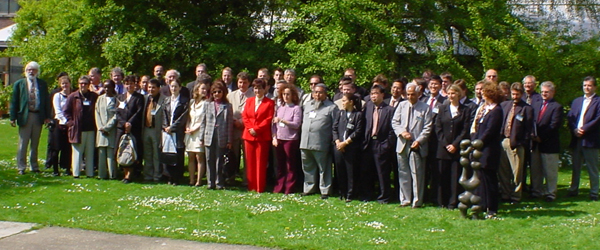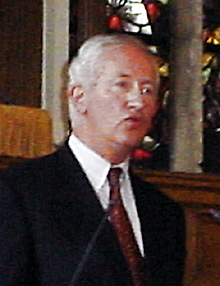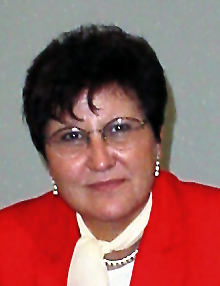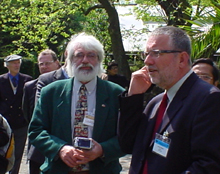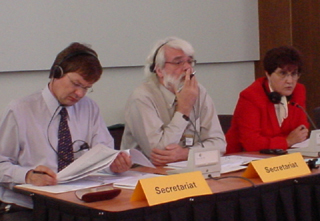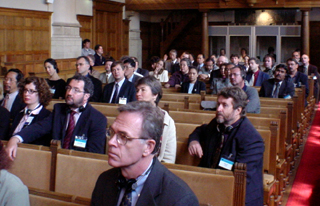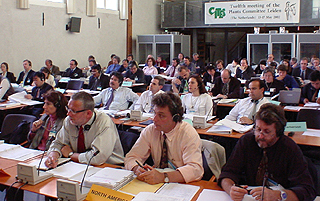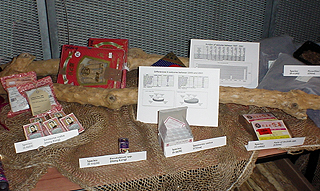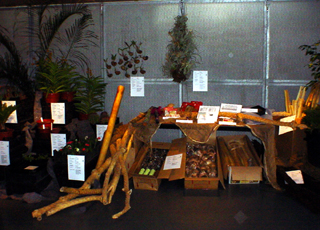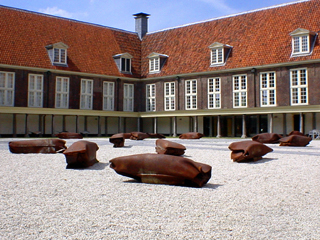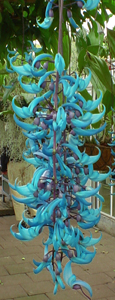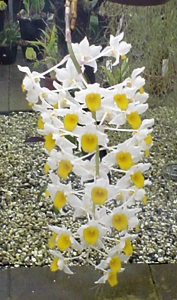|
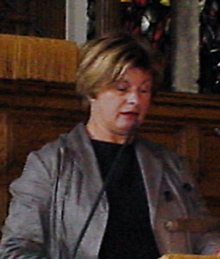 |
|
Opening
Ceremony:
Participants met Monday morning, 13 May, at Leiden University and Botanic
Garden to officially open the meeting. Geke Faber, Dutch Secretary of
State for the Ministry of Agriculture, Nature Management and Fisheries,
welcomed participants on behalf of the Dutch government. She noted that:
almost 60% of world trade in flowers and plants passes through the Netherlands;
trade in cultivated specimens takes pressure off wild populations; and
CITES can play an important role in forest protection. She stressed
that there are benefits to be gained from cooperation between the Convention
on Biological Diversity and CITES, highlighting the new working programme
on forests that came out of the CBD Sixth Conference of the Parties.
 Listen
to the RealAudio
Listen
to the RealAudio
D. D. Breimer, rector magnificus of Leiden University, expressed
respect for the work of the Plants Committee, to which the staff of
the Leiden Botanic Garden will be contributing.
Welcoming participants, Margarita Clemente (Spain), Chair of the Plants
Committee, expressed gratitude to the Netherlands for hosting the meeting
and to all those who helped with preparations and organization. She
noted the host country is well-known for its horticultural industry
and trade in propagated plants and praised university and government
collaboration regarding CITES.
On Monday afternoon, 13 May, members adopted the Rules of Procedure
(PC12/Doc. 2), Agenda (PC12/Doc. 3.1) and Working Programme (PC12/Doc.
3.2). A working group was established, with the regional representative
for North America as Chair, to discuss problems and inconsistencies
in Resolution Conf. 8.9 on the significant trade in plants. The Secretariat
introduced the admission of observers (PC12/Doc. 4), including 14 inter-governmental
and non-governmental organizations, which was adopted.
REPORT OF THE STANDING COMMITTEE:
Chair Clemente introduced the report of the Standing Committee,
stressing the need to further discuss the criteria for Appendices amendments
to allow time to reach consensus. Mexico added that all comments made
on this issue over the years should be taken into consideration.
 Listen
to the RealAudio
Listen
to the RealAudio
Chair Clemente noted a series of minor changes made to the implementation
of strategic planning (PC12/Doc. 7.3), which was adopted at the 46th
meeting of the Standing Committee in Geneva in March 2002. She asked
that a working group be formed to discuss how to move forward on the
plan's objectives and action points, including, inter alia, the need
to: assist in the development of appropriate domestic legislation; ensure
that the Convention's Appendices reflect the conservation and management
needs of species; promote cooperation among national, regional and international
law enforcement agencies; and strengthen communication and collaboration
with national and international NGOs.
Plants Committee Vice-Chair Bertrand von Arx (North America) presented
the action points directed to the Plants Committee (PC12/Doc. 15). He
noted that actions were prioritized and should be re-evaluated periodically
for highest possible efficiency. Chair Clemente stressed the need to
develop indicators as the strategic planning is constantly changing
and actions are completed. The Secretariat encouraged the Plants Committee
to focus on relevant priority actions and avoid spending time on things
that are "nice" rather than important.
FOLLOW-UP OF COP-11 DECISIONS:
Guaiacum spp.: Mexico responded to a document prepared by
TRAFFIC North America on the status of lignum vitae or tree of life
(Guaiacum) research in Mexico, stating that further work is needed
on Guaiacum coulteri and on non-detriment findings. He
added there will be discussion with the US Forest Service regarding
funding for this project.
Outlining their proposal regarding inclusion of Guaiacum spp. on Appendix
II, Germany said that both G. sanctum and G. coulteri
are traded, but that the species are indistinguishable except by highly
sophisticated methods. In order to address "look-alike" issues, he suggested
that all species of Guaiacum be listed on Appendix II to curb trade
in those that are endangered. Mexico, one of the range States, with
TRAFFIC International, and the regional representatives of Africa, Asia,
Oceania and Central and South America and the Caribbean, supported the
German proposal. World Conservation Trust of Switzerland (IWMC-CH) said
there should be information on all species of Guaiacum. The regional
representative for Africa questioned the need to have information on
all look-alike species if they are to be listed anyway, to which the
Secretariat responded that Resolution Conf. 9.24 addresses this issue
and that non-detriment findings must be made.
The CITES Secretariat suggested other options might be to undertake
a significant trade review of the species or ask range States about
what other measures they can take to prevent unsustainable trade in
species, such as implementing quotas.
IWMC-CH enquired about the use of annotations for the listing of Guaiacum
spp. Oceania asked if there were any intentions to research possible
methods for distinguishing between naturally or plantation-grown trees.
The Secretariat responded that solutions are needed that are not necessarily
high-tech and that can be enforced by customs agencies around the world.
The regional representative for North America expressed concern about
fulfilling the requirements of Decision 11.114 (regarding Guaiacum
spp.). The Secretariat said that the Plants Committee could report to
the COP that it did not fulfill the designated tasks, which could remain
on future meeting agendas. Participants agreed to forward the German
proposal to COP-12
 Listen
to a part of the discussion
Listen
to a part of the discussion
|
|


